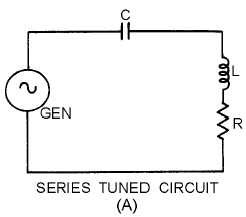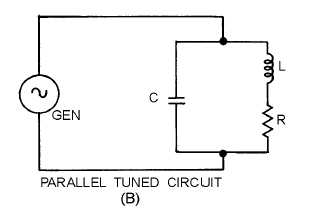1-2
You also learned that if the frequency applied to an LCR circuit causes XL and XC to be equal, the
circuit is RESONANT.
If you realize that XL and XC can be equal ONLY at ONE FREQUENCY (the resonant frequency),
then you will have learned the most important single fact about resonant circuits. This fact is the principle
that enables tuned circuits in the radio receiver to select one particular frequency and reject all others.
This is the reason why so much emphasis is placed on XL and X
C
in the discussions that follow.
Examine figure 1-1. Notice that a basic tuned circuit consists of a coil and a capacitor, connected
either in series, view (A), or in parallel, view (B). The resistance (R) in the circuit is usually limited to the
inherent resistance of the components (particularly the resistance of the coil). For our purposes we are
going to disregard this small resistance in future diagrams and explanations.
Figure 1-1A.—Basic tuned circuits. SERIES TUNED CIRCUIT
Figure 1-1B.—Basic tuned circuits. PARALLEL TUNED CIRCUIT
You have already learned how a coil and a capacitor in an a.c. circuit perform. This action will be the
basis of the following discussion about tuned circuits.
Why should you study tuned circuits? Because the tuned circuit that has been described above is
used in just about every electronic device, from remote-controlled model airplanes to the most
sophisticated space satellite.



